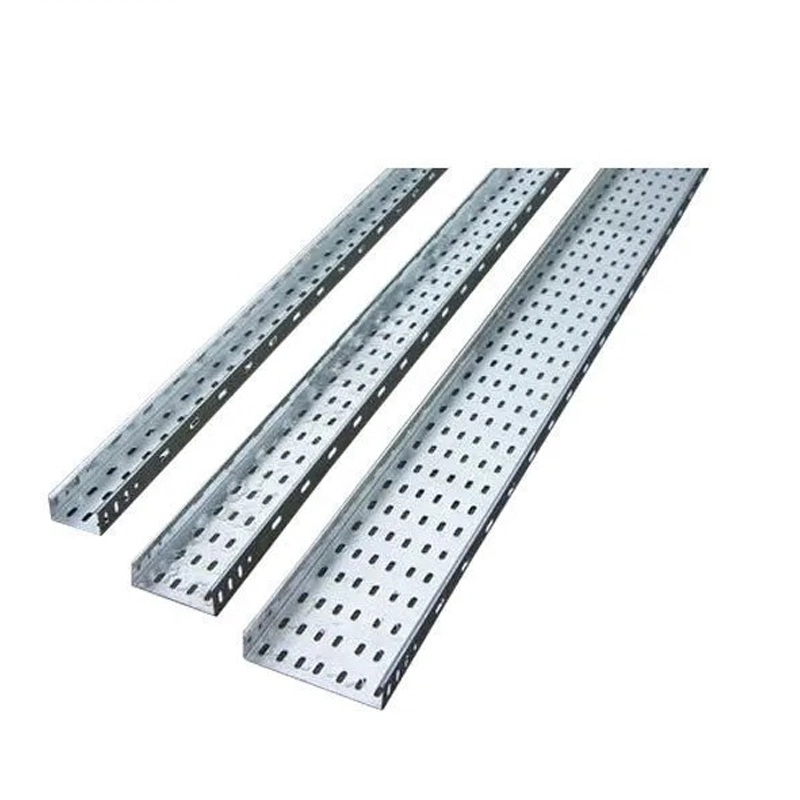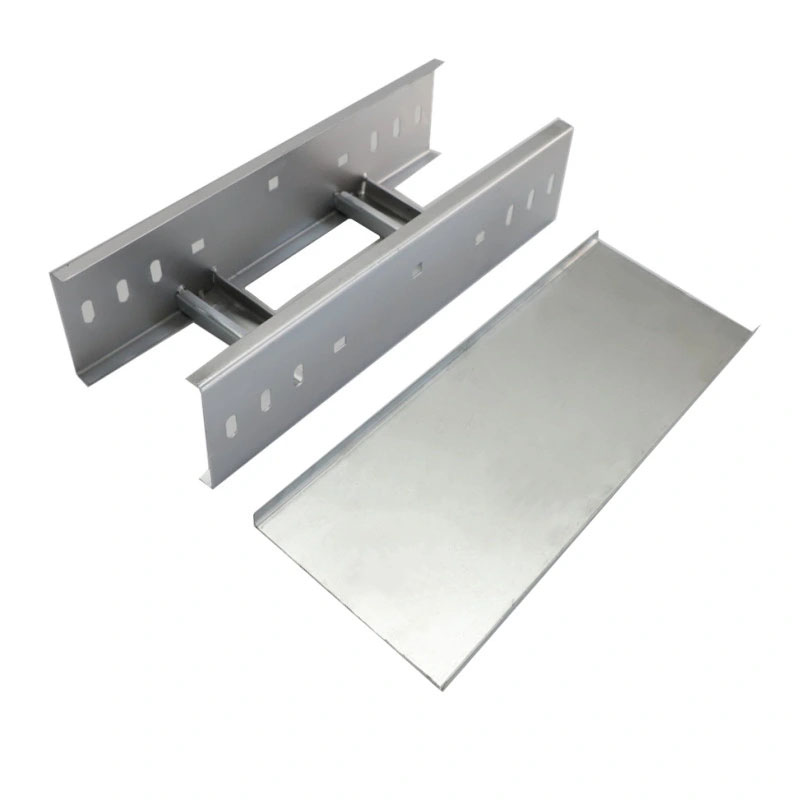How does the ladder cable trough double cable management efficiency?
Release Time : 2025-11-19
In modern buildings, data centers, industrial automation, and intelligent building systems, the number of cables is exploding. Managing these "nerve vessels" efficiently, safely, and neatly has become a key challenge in engineering design. While traditional rectangular or square cable trays are simple in structure, they often face problems such as low space utilization, poor heat dissipation, and difficulty in expansion during actual cabling. The ladder cable trough, with its unique beveled cross-section design, cleverly utilizes geometric principles to achieve a "space magic" effect—significantly improving cable capacity and organization efficiency, and optimizing heat dissipation, maintenance, and expansion performance, truly making cable management more efficient and intelligent.
1. Beveled Structure Frees Up Vertical Space, Increasing Fill Rate Without Crowding
The core innovation of the ladder cable trough lies in its cross-sectional shape, wider at the top and narrower at the bottom. Compared to the drawbacks of rectangular troughs with vertical inner walls and easy cable stacking and compaction, the beveled sides of the trapezoidal trough naturally form "guide ramps," allowing cables to be naturally layered along the slope during laying, avoiding mutual compression and tangling. This structure effectively utilizes the wider space at the top of the channel, allowing more cables to be laid out loosely and parallel, increasing cable capacity per unit cross-section while avoiding signal interference or heat dissipation obstruction caused by overfilling. Especially in scenarios with mixed high- and low-voltage wiring, the beveled edge can also assist in zone isolation, reducing the risk of electromagnetic coupling.
2. Optimized Air Convection, Constructing Passive Heat Dissipation Channels
Heat accumulation in densely cabled areas poses a risk of aging and even fire. The beveled edge design of the trapezoidal channel physically expands the gap between the cables and the channel wall, forming multiple micro-ventilation corridors. Hot air can rise along the slope, while cool air is replenished from the bottom, naturally forming convection circulation and significantly improving heat dissipation efficiency. Some high-end products also add guide ribs or perforated arrays on the inner side of the beveled edge to further enhance airflow disturbance. Compared to a closed rectangular channel, the trapezoidal structure can reduce the cable surface temperature by 5–10°C under the same load, extending service life and ensuring long-term stable system operation.
3. Convenient Installation and Flexible Expansion, Reducing Overall Maintenance Costs
The open design of the ladder cable trough greatly improves construction and maintenance efficiency. The "trumpet mouth" effect created by the beveled edges makes cable insertion smoother, eliminating the need for forceful pulling and reducing the risk of insulation damage. When adding cables later, workers can easily insert new cables from above without disassembling the entire trough or interrupting existing lines. Furthermore, the trapezoidal trough often uses a modular splicing structure, supporting seamless connection of quick-connect elbows, tees, crosses, and other accessories, adapting to complex layouts. Its top usually has a pre-installed snap-on cover or quick-opening protective cover, ensuring safety while achieving "second-level opening and immediate maintenance," significantly reducing maintenance time and labor costs.
4. Aesthetics and Function Integration, Adapting to Diverse Scenarios
In addition to performance advantages, the ladder cable trough also boasts a more modern visual appeal. Its smooth beveled lines break away from the traditional square and rigid industrial impression, making it particularly suitable for aesthetically pleasing office areas, showrooms, or smart home environments. The surface can be powder-coated, anodized, or finished with a wood grain finish to coordinate with interior design styles. Meanwhile, a variety of materials are available—galvanized steel sheets are suitable for heavy-duty industrial applications, lightweight and corrosion-resistant aluminum alloys are ideal for cleanrooms, and engineering plastics are used in anti-static or corrosive environments, meeting the customized needs of different industries.
The "spatial magic" of the ladder cable trough essentially transforms simple geometric deformation into a highly efficient engineering solution. Using a pair of beveled edges, it restructures the cable layout logic, thermal management path, and human-machine interaction, achieving a qualitative leap from simply "installable" to "easy to install, easy to manage, and easy to dissipate heat." In today's era of intelligent, high-density cabling, this seemingly minor cross-sectional innovation, with its superior overall performance, is becoming an indispensable and efficient carrier in modern cable management systems, truly allowing each cable to "travel freely and without obstruction."
1. Beveled Structure Frees Up Vertical Space, Increasing Fill Rate Without Crowding
The core innovation of the ladder cable trough lies in its cross-sectional shape, wider at the top and narrower at the bottom. Compared to the drawbacks of rectangular troughs with vertical inner walls and easy cable stacking and compaction, the beveled sides of the trapezoidal trough naturally form "guide ramps," allowing cables to be naturally layered along the slope during laying, avoiding mutual compression and tangling. This structure effectively utilizes the wider space at the top of the channel, allowing more cables to be laid out loosely and parallel, increasing cable capacity per unit cross-section while avoiding signal interference or heat dissipation obstruction caused by overfilling. Especially in scenarios with mixed high- and low-voltage wiring, the beveled edge can also assist in zone isolation, reducing the risk of electromagnetic coupling.
2. Optimized Air Convection, Constructing Passive Heat Dissipation Channels
Heat accumulation in densely cabled areas poses a risk of aging and even fire. The beveled edge design of the trapezoidal channel physically expands the gap between the cables and the channel wall, forming multiple micro-ventilation corridors. Hot air can rise along the slope, while cool air is replenished from the bottom, naturally forming convection circulation and significantly improving heat dissipation efficiency. Some high-end products also add guide ribs or perforated arrays on the inner side of the beveled edge to further enhance airflow disturbance. Compared to a closed rectangular channel, the trapezoidal structure can reduce the cable surface temperature by 5–10°C under the same load, extending service life and ensuring long-term stable system operation.
3. Convenient Installation and Flexible Expansion, Reducing Overall Maintenance Costs
The open design of the ladder cable trough greatly improves construction and maintenance efficiency. The "trumpet mouth" effect created by the beveled edges makes cable insertion smoother, eliminating the need for forceful pulling and reducing the risk of insulation damage. When adding cables later, workers can easily insert new cables from above without disassembling the entire trough or interrupting existing lines. Furthermore, the trapezoidal trough often uses a modular splicing structure, supporting seamless connection of quick-connect elbows, tees, crosses, and other accessories, adapting to complex layouts. Its top usually has a pre-installed snap-on cover or quick-opening protective cover, ensuring safety while achieving "second-level opening and immediate maintenance," significantly reducing maintenance time and labor costs.
4. Aesthetics and Function Integration, Adapting to Diverse Scenarios
In addition to performance advantages, the ladder cable trough also boasts a more modern visual appeal. Its smooth beveled lines break away from the traditional square and rigid industrial impression, making it particularly suitable for aesthetically pleasing office areas, showrooms, or smart home environments. The surface can be powder-coated, anodized, or finished with a wood grain finish to coordinate with interior design styles. Meanwhile, a variety of materials are available—galvanized steel sheets are suitable for heavy-duty industrial applications, lightweight and corrosion-resistant aluminum alloys are ideal for cleanrooms, and engineering plastics are used in anti-static or corrosive environments, meeting the customized needs of different industries.
The "spatial magic" of the ladder cable trough essentially transforms simple geometric deformation into a highly efficient engineering solution. Using a pair of beveled edges, it restructures the cable layout logic, thermal management path, and human-machine interaction, achieving a qualitative leap from simply "installable" to "easy to install, easy to manage, and easy to dissipate heat." In today's era of intelligent, high-density cabling, this seemingly minor cross-sectional innovation, with its superior overall performance, is becoming an indispensable and efficient carrier in modern cable management systems, truly allowing each cable to "travel freely and without obstruction."







